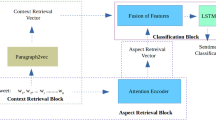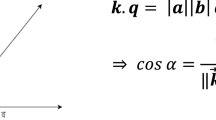Abstract
Different embeddings capture various linguistic aspects, such as syntactic, semantic, and contextual information. Taking into account the diverse linguistic facets, we propose a novel hybrid model. This model hinges on the amalgamation of multiple embeddings through an attention encoder, subsequently channeled into an LSTM framework for sentiment classification. Our approach entails the fusion of Paragraph2vec, ELMo, and BERT embeddings to extract contextual information, while FastText is adeptly employed to capture syntactic characteristics. Subsequently, these embeddings were fused with the embeddings obtained from the attention encoder which forms the final embeddings. LSTM model is used for predicting the final classification. We conducted experiments utilizing both the Twitter Sentiment140 and Twitter US Airline Sentiment datasets. Our fusion model’s performance was evaluated and compared against established models such as LSTM, Bi-directional LSTM, BERT and Att-Coder. The test results clearly demonstrate that our approach surpasses the baseline models in terms of performance.






Similar content being viewed by others
References
Cambria E, Das D, Bandyopadhyay S, Feraco A et al (2017) A practical guide to sentiment analysis. Springer, Berlin
Zárate JM, Santiago SM (2019) Sentiment analysis through machine learning for the support on decision-making in job interviews. In: International conference on human–computer interaction. Springer, Berlin, pp 202–213
Xiong S, Wang K, Ji D, Wang B (2018) A short text sentiment-topic model for product reviews. Neurocomputing 297:94–102
Groß-Klußmann A, König S, Ebner M (2019) Buzzwords build momentum: global financial twitter sentiment and the aggregate stock market. Expert Syst Appl 136:171–186
Lin C, He Y (2009) Joint sentiment/topic model for sentiment analysis. In: Proceedings of the 18th ACM conference on information and knowledge management, pp 375–384
Shoukry A, Rafea A (2012) Sentence-level Arabic sentiment analysis. In: 2012 International conference on collaboration technologies and systems (CTS). IEEE, pp 546–550
Schouten K, Frasincar F (2015) Survey on aspect-level sentiment analysis. IEEE Trans Knowl Data Eng 28(3):813–830
Zhang L, Wang S, Liu B (2018) Deep learning for sentiment analysis: a survey. Wiley Interdiscip Rev: Data Mini Knowl Discov 8(4):e1253
Da Silva NF, Hruschka ER, Hruschka ER Jr (2014) Tweet sentiment analysis with classifier ensembles. Decis Support Syst 66:170–179
Joachims T (1998) Text categorization with support vector machines: learning with many relevant features. In: European conference on machine learning. Springer, Berlin, pp 137–142
Bengio Y, Ducharme R, Vincent P, Jauvin C (2003) A neural probabilistic language model. J Mach Learn Res 3(Feb):1137–1155
Neethu M, Rajasree R (2013) Sentiment analysis in twitter using machine learning techniques. In: 2013 fourth international conference on computing, communications and networking technologies (ICCCNT). IEEE, pp 1–5
Jadav BM, Vaghela VB (2016) Sentiment analysis using support vector machine based on feature selection and semantic analysis. Int J Comput Appl 146(13):26–30
Ajit P (2016) Prediction of employee turnover in organizations using machine learning algorithms. Algorithms 4(5):C5
Chen P, Xu B, Yang M, Li S (2016) Clause sentiment identification based on convolutional neural network with context embedding. In: 2016 12th international conference on natural computation, fuzzy systems and knowledge discovery (ICNC-FSKD). IEEE, pp 1532–1538
Jain PK, Saravanan V, Pamula R (2021) A hybrid CNN-LSTM: a deep learning approach for consumer sentiment analysis using qualitative user-generated contents. Trans Asian Low-Resour Lang Inf Process 20(5):1–15
Zhang M, Zhang Y, Vo D-T (2016) Gated neural networks for targeted sentiment analysis. In: Thirtieth AAAI conference on artificial intelligence
Tang D, Qin B, Feng X, Liu T (2015) Effective LSTMS for target-dependent sentiment classification. arXiv preprint arXiv:1512.01100
Vaswani A, Shazeer N, Parmar N, Uszkoreit J, Jones L, Gomez AN, Kaiser Ł, Polosukhin I (2017) Attention is all you need. In: Advances in neural information processing systems, pp 5998–6008
Wang J, Li J, Li S, Kang Y, Zhang M, Si L, Zhou G (2018) Aspect sentiment classification with both word-level and clause-level attention networks. IJCAI 2018:4439–4445
Ma Y, Peng H, Cambria E (2018) Targeted aspect-based sentiment analysis via embedding commonsense knowledge into an attentive LSTM. In: Thirty-second AAAI conference on artificial intelligence
Soni J, Mathur K (2022) Sentiment analysis based on aspect and context fusion using attention encoder with LSTM. Int J Inf Technol 14(7):3611–3618
Sukhbaatar S, Szlam A, Weston J, Fergus R (2015) End-to-end memory networks, arXiv preprint arXiv:1503.08895
Chen P, Sun Z, Bing L, Yang W (2017) Recurrent attention network on memory for aspect sentiment analysis. In: Proceedings of the 2017 conference on empirical methods in natural language processing, pp 452–461
Zhu P, Qian T (2018) Enhanced aspect level sentiment classification with auxiliary memory. In: Proceedings of the 27th international conference on computational linguistics, pp 1077–1087
Naseem U, Razzak I, Musial K, Imran M (2020) Transformer based deep intelligent contextual embedding for twitter sentiment analysis. Futur Gener Comput Syst 113:58–69
Dowlagar S, Mamidi R (2021) Cmsaone@ dravidian-codemix-fire2020: a meta embedding and transformer model for code-mixed sentiment analysis on social media text, arXiv preprint arXiv:2101.09004
He J, Mai S, Hu H (2021) A unimodal reinforced transformer with time squeeze fusion for multimodal sentiment analysis. IEEE Signal Process Lett 28:992–996
Bacco L, Cimino A, Dell’Orletta F, Merone M (2021) Extractive summarization for explainable sentiment analysis using transformers. In 18th extended semantic web conference 2021
Yang J, Li Y, Gao C, Zhang Y (2021) Measuring the short text similarity based on semantic and syntactic information. Futur Gener Comput Syst 114:169–180
Lin T, Sun A, Wang Y (2023) EDU-capsule: aspect-based sentiment analysis at clause level. Knowl Inf Syst 65(2):517–541
Das R, Singh TD (2023) Multimodal sentiment analysis: a survey of methods, trends and challenges. ACM Comput Surv 270:1–38
Le Q, Mikolov T (2014) Distributed representations of sentences and documents. In: International conference on machine learning. PMLR, pp 1188–1196
Chen X, Hui K, He B, Han X, Sun L, Ye Z (2021) Co-BERT: a context-aware BERT retrieval model incorporating local and query-specific context, arXiv preprint arXiv:2104.08523
Elbedwehy S, Thron C, Alrahmawy M, Hamza T (2022) Real-time detection of first stories in twitter using a fasttext model. In: Artificial intelligence for data science in theory and practice. Springer, Berlin, pp 179–218
Hochreiter S, Schmidhuber J (1997) Long short-term memory. Neural Comput 9(8):1735–1780
Dua D, Graff C (2017) UCI machine learning repository (online). Available: http://archive.ics.uci.edu/ml
Graves A, Fernández S, Schmidhuber J (2005) Bidirectional LSTM networks for improved phoneme classification and recognition. In: International conference on artificial neural networks. Springer, Berlin, pp 799–804
Devlin J, Chang M-W, Lee K, Toutanova K (2018) Bert: pre-training of deep bidirectional transformers for language understanding, arXiv preprint arXiv:1810.04805
Liu Y, Ott M, Goyal N, Du J, Joshi M, Chen D, Levy O, Lewis M, Zettlemoyer L, Stoyanov V (2019) Roberta: a robustly optimized BERT pretraining approach, arXiv preprint arXiv:1907.11692
Meyes R, Lu M, de Puiseau CW, Meisen T (2019) Ablation studies in artificial neural networks, arXiv preprint arXiv:1901.08644
Ruan D, Yan Y, Lai S, Chai Z, Shen C, Wang H (2021) Feature decomposition and reconstruction learning for effective facial expression recognition. In: Proceedings of the IEEE/CVF conference on computer vision and pattern recognition, pp 7660–7669
Grzegorowski M, Dominik, (2019) On resilient feature selection: computational foundations of rc-reducts. Inf Sci 499:25–44
Author information
Authors and Affiliations
Corresponding author
Additional information
Publisher's Note
Springer Nature remains neutral with regard to jurisdictional claims in published maps and institutional affiliations.
Rights and permissions
Springer Nature or its licensor (e.g. a society or other partner) holds exclusive rights to this article under a publishing agreement with the author(s) or other rightsholder(s); author self-archiving of the accepted manuscript version of this article is solely governed by the terms of such publishing agreement and applicable law.
About this article
Cite this article
Soni, J., Mathur, K. Enhancing sentiment analysis via fusion of multiple embeddings using attention encoder with LSTM. Knowl Inf Syst (2024). https://doi.org/10.1007/s10115-024-02102-w
Received:
Revised:
Accepted:
Published:
DOI: https://doi.org/10.1007/s10115-024-02102-w




